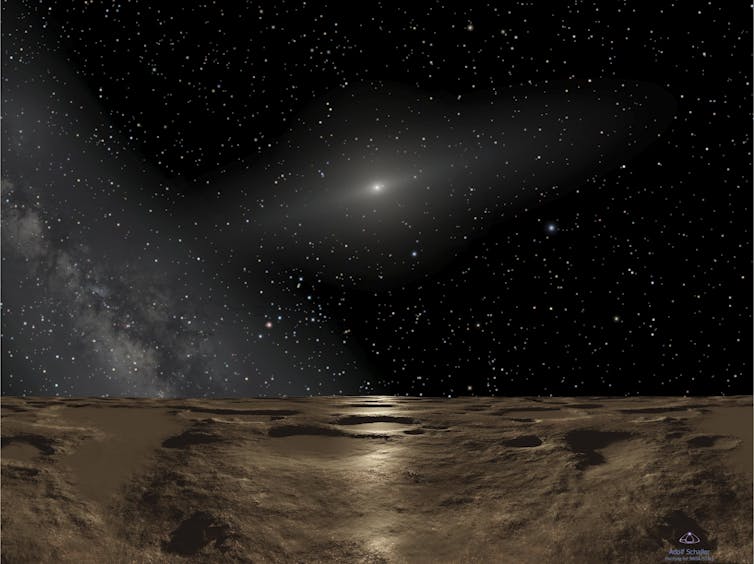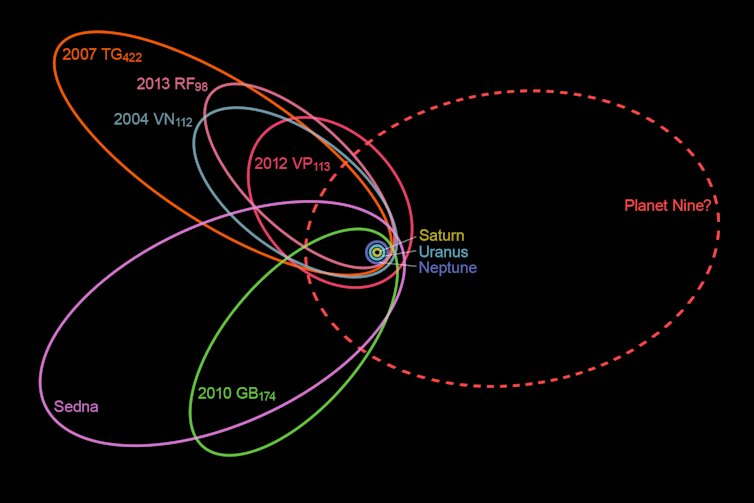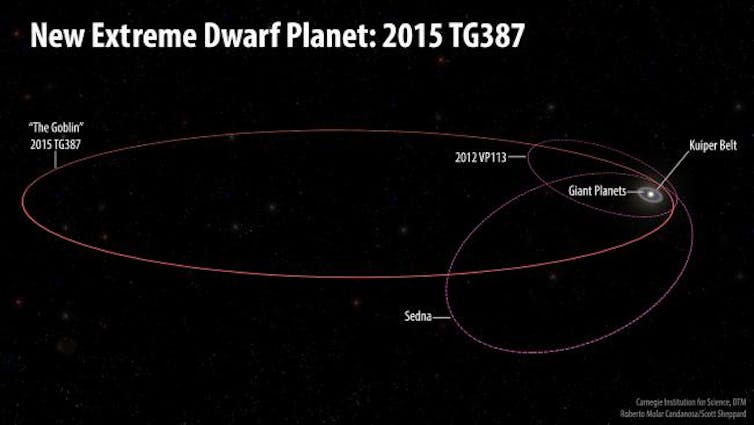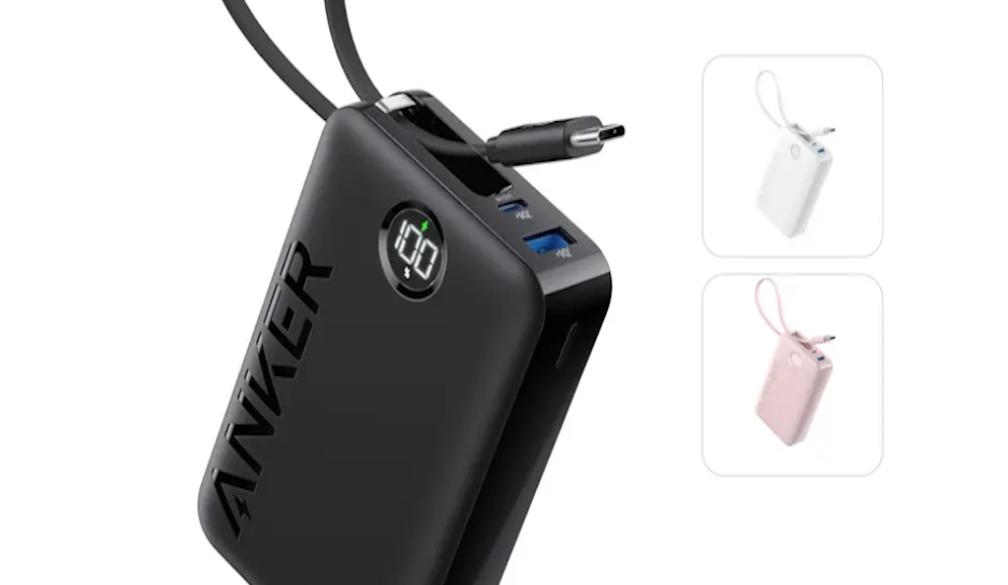A Goblin could guide us to a mystery planet thought to exist in the Solar system
- Written by Jonti Horner, Professor (Astrophysics), University of Southern Queensland
Out in the depths of the Solar system, astronomers recently discovered a small, icy object, named 2015 TG387.
First observed in October 2015, it has been nicknamed “The Goblin” by its discoverers. It is currently almost 12 billion kilometres from the Sun – about 80 times the distance between Earth and the Sun (or 80au, where 1au is the distance from Earth to the Sun).
“The Goblin” is thought to be about 300km in diameter, and moves on a highly elongated orbit, far beyond the realm of the eight planets (Mercury to Neptune). It is so distant that it takes more than 34,000 years to orbit the Sun.
Read more: Discovered: a huge liquid water lake beneath the southern pole of Mars
What’s most exciting about the new discovery, though, is that it might hold the key to helping astronomers discover an unseen planet that some believe lurks in the Solar system’s icy depths.
The history of Planet X
In 1984, research suggested that, over the past 250 million years, mass extinctions had happened on Earth every 26 million years. But what could cause such periodic extinctions?
A hypothetical red dwarf star, known as Nemesis, was proposed to orbit the Sun at a great distance. Every 26 million years, as it passed through its closest approach to the Sun, the star would scatter a deluge of comets towards the inner Solar system. The result? One or more of those comets would collide with Earth, triggering a mass extinction.
But over the years the evidence waned, and no companion star was found. Nemesis passed into history.
At the turn of the millennium, a new “Planet X” was proposed - nicknamed Tyche. Where Nemesis was the bringer of death, Tyche’s influence was more subtle, resulting in a slight increase in the number of inbound comets from certain regions of the sky, and explaining observed peculiarities in the distribution of those comets.
Once again, observations soon weakened the case for Tyche. The final nail came with NASA’s Wide-field Infrared Survey Explorer (WISE), which looked at the entire sky at infrared wavelengths. If Tyche existed, WISE would almost certainly have found it.
Still, the idea of an unseen planet beyond Neptune’s orbit rears its head every few years. In 2008 an unseen, distant Earth-mass planet was proposed to explain the distribution of small, icy bodies beyond Neptune.
Other researchers pointed out that planet-mass objects could have formed along with the Solar system’s outer planets, before being scattered outward, but never ejected.
All this brings us to Planet X’s latest incarnation - known as “Planet Nine”.
Planet X reborn: Planet Nine
The story of Planet Nine begins with Sedna, a dwarf planet discovered beyond Pluto in November 2003. Sedna has a highly unusual orbit, with its orbital distance varying between 76au and 936au from the Sun. This poses an obvious question: how did Sedna get captured in that orbit?
 Artist’s impression of the view from Sedna, looking back towards the Sun.
NASA, ESA and Adolf Schaller
Artist’s impression of the view from Sedna, looking back towards the Sun.
NASA, ESA and Adolf Schaller
At its closest, Sedna is too distant for the planets to perturb it - they cannot be responsible. At its farthest, Sedna is still just one 1/400th of the distance to the nearest star – so close to the Sun that it is very unlikely a passing star could do the deed.
To explain the odd orbit, several theorists suggested that Sedna could have been placed on its orbit when the Solar system was young. At that time, the Sun would have been embedded within a stellar cluster, and close encounters with other stars would have been more frequent.
Now, if Sedna’s orbit was the result of capture during the Solar system’s youth, one might expect other objects to have shared the same fate. The theory therefore predicted that Sedna could be one of a population of Sednoids, all moving on similar orbits.
In the past decade, several more Sednoids have been found. Peculiarly, all of their orbits seem to align, roughly, in space. In other words, the long axes of their orbits all point in roughly the same direction. This is not what you would expect of a population born of the Sun’s birth cluster. So what could be the cause?
To explain Sedna’s unusual orbit, several researchers invoked a variety of Planets X. As new objects were discovered, these theories were continually revisited, until US researchers Konstantin Batygin and Mike Brown came up with the current version, which they nicknamed “Planet Nine”.
Batygin and Brown propose that Planet Nine is comparable in mass to Neptune, moving on a highly eccentric orbit, with a period of around 15,000 years.
 The orbits of six ‘detached’ trans-Neptunian objects roughly align in space. Perhaps their similar orbits are the result of Planet Nine’s influence?
nagualdesign/Wikimedia
The orbits of six ‘detached’ trans-Neptunian objects roughly align in space. Perhaps their similar orbits are the result of Planet Nine’s influence?
nagualdesign/Wikimedia
With this theory comes a prediction: as more Sednoids are found, the evidence for the planet will grow, as those objects will also have been sculpted to their current orbits by the hidden planet’s influence.
But astronomers are not universally convinced that an unseen planet is to blame for the alignment of the unusual objects. Extraordinary claims require extraordinary evidence, and there has been much debate over whether the theory stands up to scrutiny.
As with Tyche, proposed at the turn of the millennium, the apparent clustering of these distant objects could instead be the result of observational biases.
Simply put, we are more likely to find such faint objects in some parts of the night sky than in others. Since we find those objects at or near perihelion – when they are nearest to the Sun, so at their brightest – that would naturally create just such a cluster of orbits from the first discoveries.
How to break the impasse? More discoveries are needed. Which brings us to our newly discovered friend, “The Goblin”.
Discovering our ghoulish friend
2015 TG387 was first observed on October 13, 2015, with follow-up observations carried out over the past three years. The extended observations show TG387’s orbit is even more extreme than Sedna’s.
 The orbit of 2015 TG387 is even more extreme than Sedna’s - but is oriented in roughly the same direction, adding weight to the Planet Nine hypothesis.
Robert Molar Candanosa & Scott Sheppard, Carnegie Institution for Science
The orbit of 2015 TG387 is even more extreme than Sedna’s - but is oriented in roughly the same direction, adding weight to the Planet Nine hypothesis.
Robert Molar Candanosa & Scott Sheppard, Carnegie Institution for Science
TG387’s orbit brings it in to around 65au, but stretches all the way out to 2,027au, and one lap takes more than 34,000 years to complete.
Like the other objects that hint at the presence of Planet Nine, TG387’s orbit is oriented just right to add weight to that hypothesis.
Read more: Planet or dwarf planet: all worlds are worth investigating
So does this mean that Planet Nine is real?
While this could be an extra piece of evidence for the planet’s existence, it is far from definitive. It could equally be the case that TG387 is further evidence that observational biases drive the clustering.
We need to find more objects before we can be sure, either way. Fortunately, there are likely to be millions of similar objects like TG387 – indeed, its discovers predict that it is just one of several million bodies, all moving on similar orbits in the Solar system’s icy depths.
Authors: Jonti Horner, Professor (Astrophysics), University of Southern Queensland



















